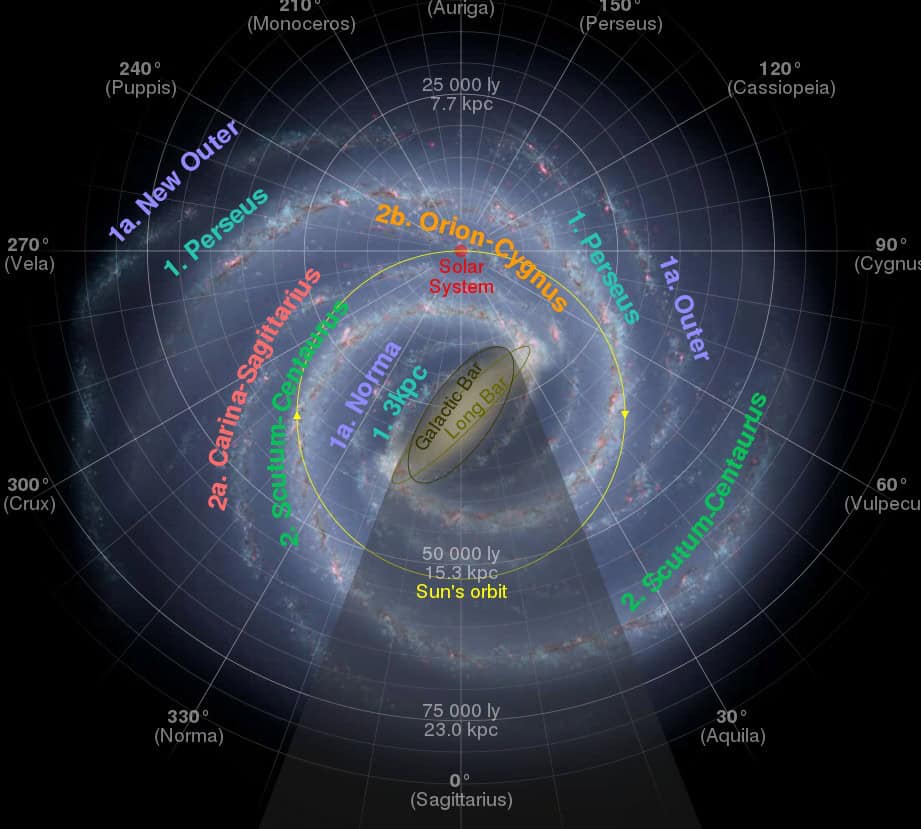

In today’s world, it has become unfashionable to gaze at the stars and seek to comprehend the principles of celestial mechanics. Unfortunately, we find ourselves preoccupied with the demands of daily life, consumed by social media and endless consumerism. Few individuals truly grasp the magnitude of what exists above us – the Sun, Moon, planets, asteroids, comets, stars, and galaxies. All of these celestial bodies are in constant motion, hurtling through space at astonishing speeds and distances. How can we hope to understand it all? This is a question that often plagues the human mind. Some may dismiss the pursuit of astronomical knowledge as trivial, opting instead to immerse themselves in the alluring world of “new” earthly technologies.
Everyone has the potential to be understood. The pursuit of material wealth in society has overshadowed our collective desire and opportunities for understanding the vastness of the Universe. Occasionally, however, there are individuals who find a moment of free time and a spark of curiosity to look beyond the confines of our earthly existence and try to grasp what lies beyond.
Listening to an astronomer talk about concepts like the ecliptic, precession, and azimuths can be intimidating. But recently, I came across some interesting information on Wiki:
According to Wiki, astronomy has not been taught as a separate subject in Russian schools for over 10 years (as of 2015). Shockingly, VTsIOM polls conducted in 2007 revealed that 29% of Russians believed that the Earth revolves around the Sun, while the remaining 33% believed the opposite – that the Sun revolves around the Earth.
And I pondered, what actions should we take?
Perhaps it would be beneficial to learn how to solve simple math equations, such as “two times two,” through gradual steps using the common language of “triplets”?
WHY IS ORION REFERENCED SO FREQUENTLY?
As you delve into the mythology and history of ancient religious structures on our planet, you will notice a recurring theme – the mention of the Orion constellation. The ancient Egyptians, for instance, associated Osiris with Orion, and the unique pyramids of Giza were constructed to mirror this celestial formation. There are numerous other sources that mention Orion, but it is noteworthy that Anastasia Novy’s books also make reference to it:
The ancient Egyptians had multiple meanings for the word “Sah.” It signified “enlightenment” and was also used to name the constellation Orion, which they regarded as the ruler of the stars. Additionally, Orion was often associated with Osiris. (Sensei IV)
The constellation Orion was commonly referred to as the embodiment of the god Osiris. (Sensei IV)
In the tamga of the Lord of Shambhala, a golden round monad with a lotus flower attached represents the constellation Orion. It features three large stones arranged in a triangle, symbolizing the delivery of a small pebble from Orion and more. (Ezoosmosis)
During the reign of Pharaoh Imhotep, the remaining Free Masons faced significant challenges, especially when it came to the construction of the third pyramid in the Orion belt. Despite these difficulties, they managed to successfully complete this monumental project. (Sensei IV)
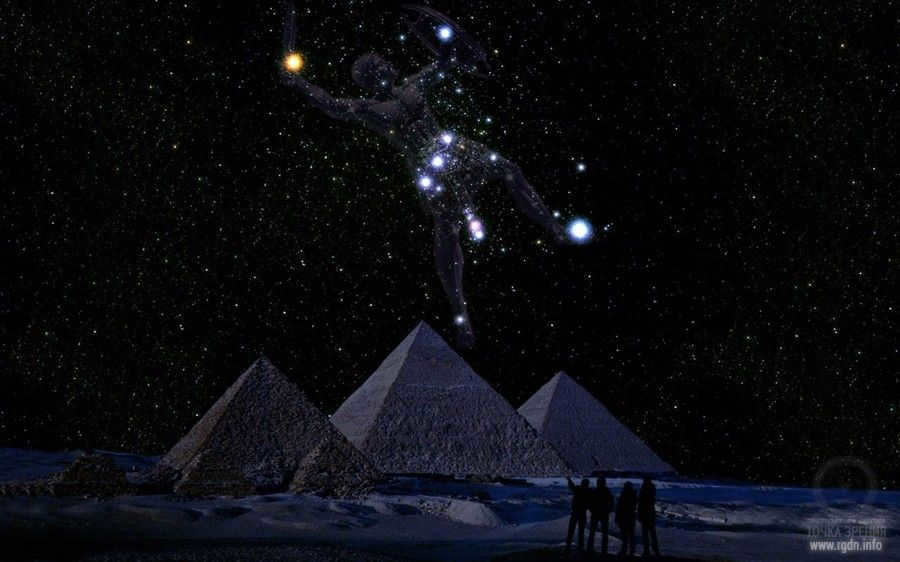
I am hopeful that we will eventually return to the most unforgettable constellation in our celestial sphere, but for now, as we eagerly await the planned stellar expedition, I would like to focus on a single intriguing aspect. It is common knowledge that the Earth, as a constituent of the Solar System, is a constituent of the Milky Way Galaxy. In the 1980s, astronomers postulated that the Milky Way is not a typical spiral galaxy, but rather a spiral galaxy with a junction, resulting in its distinct structure characterized by the presence of what are known as arms. Among these arms is the Orion arm, in which we currently find ourselves as temporary residents.
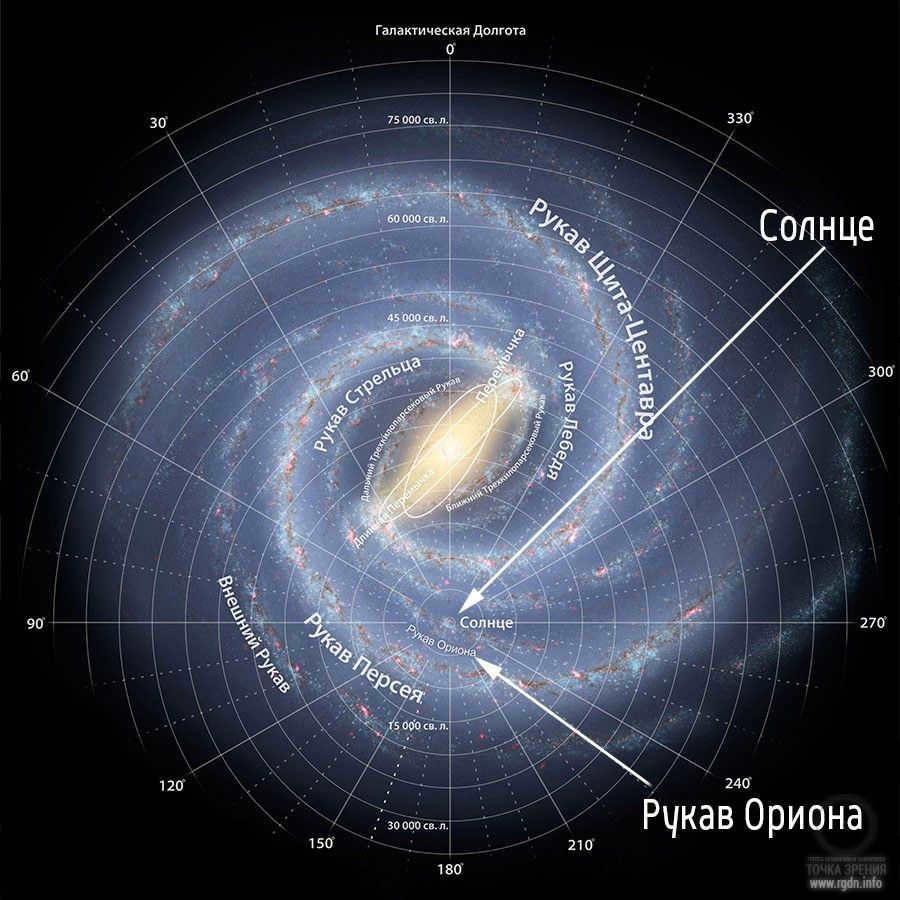
Furthermore, I came across an image on Wikipedia that shows the galaxy from a different perspective, revealing the relative proximity of another celestial object mentioned in the book “AllatRa” – the Crab Nebula M1. However, the term “proximity” is used loosely here, as it is actually located about 6500 light years away from Earth. To put it into perspective, if we were to send a beam of light traveling at a speed of 300,000 kilometers per second, it would take around 6500 years for it to reach M1. In other words, it would arrive sometime around the year 8500 AD.
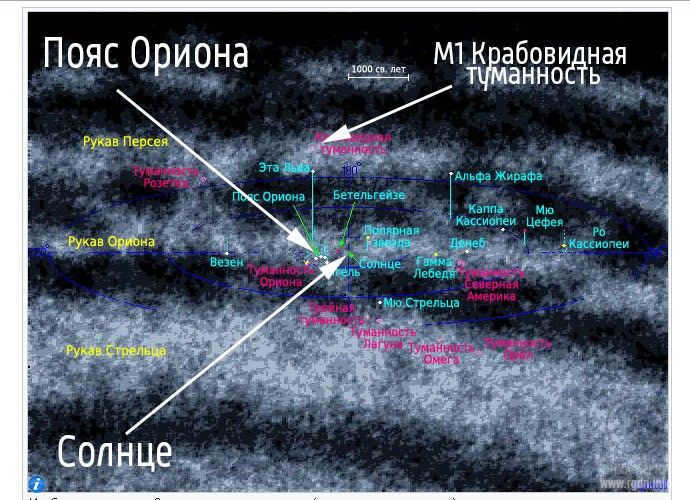
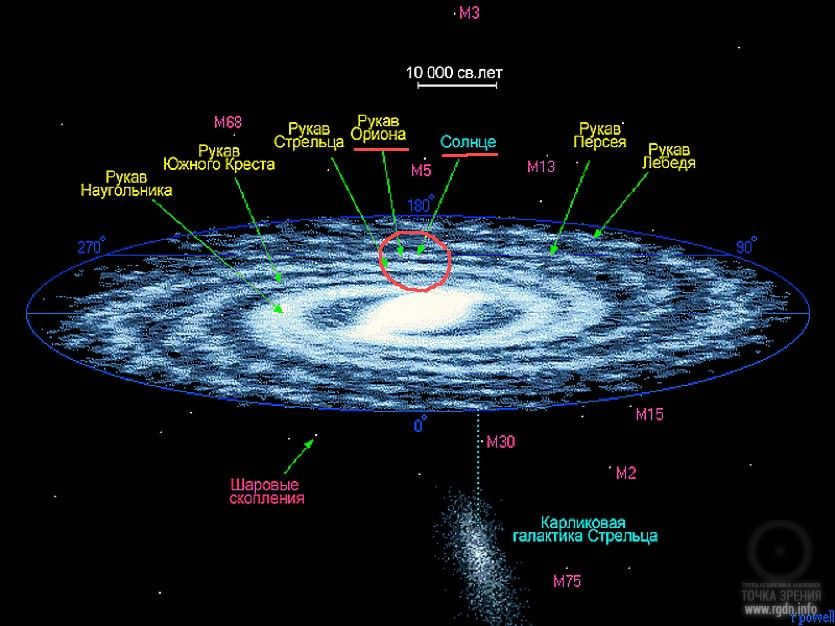
After seeing these impressive images, it might appear that the bright stars of the Orion constellation (Betelgeuse, Bellatrix, Alnitak, Alnilam, Mintaka, Rigel, Saif, Hatice) are not too far away from Earth. It may seem that way to some, but with the advancements in science, we now know that the red supergiant Betelgeuse is approximately 427-650 light years away. Nevertheless, there is still much to learn and discover. Don’t you think so?
| Orion’s arm. Or where the solar system is located. – Topic rating: 5.00 out of 5.00 voted: 179 |
Feedback

Sergey 16.11.2017 10:47 am Reply ↵
Astronomy has always been an intriguing subject, but I never delved too deeply into it. Whenever I encountered a lack of understanding, my interest immediately waned. And here’s another puzzling thought: “What kind of imagination did the ancients have?”))))), because in reality, none of the constellations actually resemble what they draw. I believe that what we see is a mere projection of the starry sky, while the ancients had a deeper understanding of the clusters and groups of stars, which they named accordingly.
And let’s take a look at a fascinating fact: the sun revolves around the earth. It may sound like a joke, but is it really true?
When I was a child, I pondered the concept of the universe’s edge. I would strain my eyes as much as possible, trying to see what lies beyond. My mind would race with thoughts of what could be at the edge, and it was truly mind-boggling.
Have you heard the tale of the Clear Falcon, as interpreted by Nikolai Levashov? It’s an intriguing story that has been passed down through generations. Over time, the text of the story has been shortened and modified, but the essence remains the same. One particular moment in the tale involves a girl searching for her Falcon and journeying through seven pairs of iron boots. The author suggests that this is how the ancients represented the vast distances traveled by the girl as she flew from one planet to another. If you’re interested, there’s an audiobook available that delves into the details. It’s quite lengthy, but well worth the listen.

Xenia 15.11.2017 18:53 pm Reply ↵
GIRLANDA or Tuning the planets to Lad-Allat
The Universe is filled with an abundance of planets,
That are beyond the imagination of science fiction!
Tetrahedron, Octahedron and Dodecahedron,
How do the Earth’s core connect
with the planets of the outgoing chain,
At the threshold of the Crossroads of the Ages?!
The messages and activation of the pyramids are present here,
as well as the ancient ones in Antarctica.
The essence of the garland is simple: parallel, alternating current,
The power supply is eternal and unchanging.
A number of planets are aligned,
And activated through portals into them Allat.
Here on Earth, there are garlands of pyramids,
Like the ancient gardens of Semiramis,
following the design of the Lotus Flower,
With the planets and stars perfectly aligned.
These are the shifts happening in the Earth’s magnetosphere,
Signaling the dawn of a new era:
A recreation of the Fibonacci sequence,
The golden ratio will encompass the entire Earth,
Where the fusion of divine and scientific principles
In a constellation of planets through Allat will intertwine!
JuliaM ✎ Xenia 16.11.2017 15:03 Reply ↵

yura 11.11.2017 19:31 pm Reply ↵
User laplanddream made an intriguing discovery regarding the constellation of Orion and the location of the mounds where the famous “Golden Man” of Issyk was unearthed. By utilizing Google Earth, laplanddream found a correlation between the positions of the mounds and certain stars within the constellation. To showcase his findings, laplanddream created a concise video presentation for readers to enjoy.
The discovery of the “Golden Man” took place in 1969 during excavations of the Issyk mound, located 50 kilometers from Almaty. This remarkable find, dating back to the 5th-6th century BC, consists of the remains of a Saka warrior adorned in gold attire. Inside the burial mound, archaeologists recovered over four thousand pieces of gold jewelry, shoes, headdresses, statuettes, bronze and gold weapons, as well as a silver bowl engraved with 26 undeciphered symbols. The image of the “Golden Man” riding a winged leopard has become a cherished national symbol of Kazakhstan, with replicas of the Saka warrior displayed in numerous cities across the country, including one atop the Independence Monument in Almaty’s main square.
Read more: https://tengrinews.kz/strange_news/naydena-svyaz-issyikskim-zolotyim-chelovekom-sozvezdiem-279291/

Xenia 11.11.2017 12:06 am Reply ↵
Anna, thank goodness! Just now, I found myself captivated by a certain event and decided to observe the celestial map. “Where does it hail from?” I questioned. “It originates from Orion,” came the reply.))))

It’s no laughing matter to discover Life in this place!
Never give up hope, never stop being aware,
Imbue your Soul with the ONE wisdom!

Anna ✎ Xenia 11.11.2017 19:21 pm Reply ↵
Xenia, I am amazed. I have just examined the map))) Indeed, I concur with you, expressing gratitude to Him for every breath we take. Once again, I extend my heartfelt thanks to Him. Cheers!)

Aurore replied on November 11, 2017 at 12:23 am
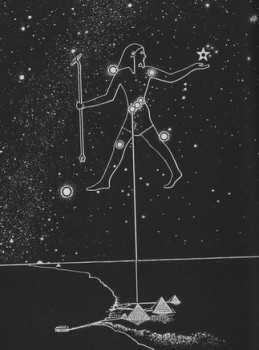
Have you ever wondered if there is a connection between the projection of the constellation of Orion on Earth and the location of the Egyptian pyramids, which represent the belt of Orion (Osiris)? Additionally, there is a geoglyph in Kiev that resembles the head of Osiris, with the lotus temple situated in the area of his third eye.
Admin ✎ Aurore 11.11.2017 20:59 Reply ↵
It seems like you may be misrepresenting the situation slightly. The constellation Orion is clearly visible in Egypt.
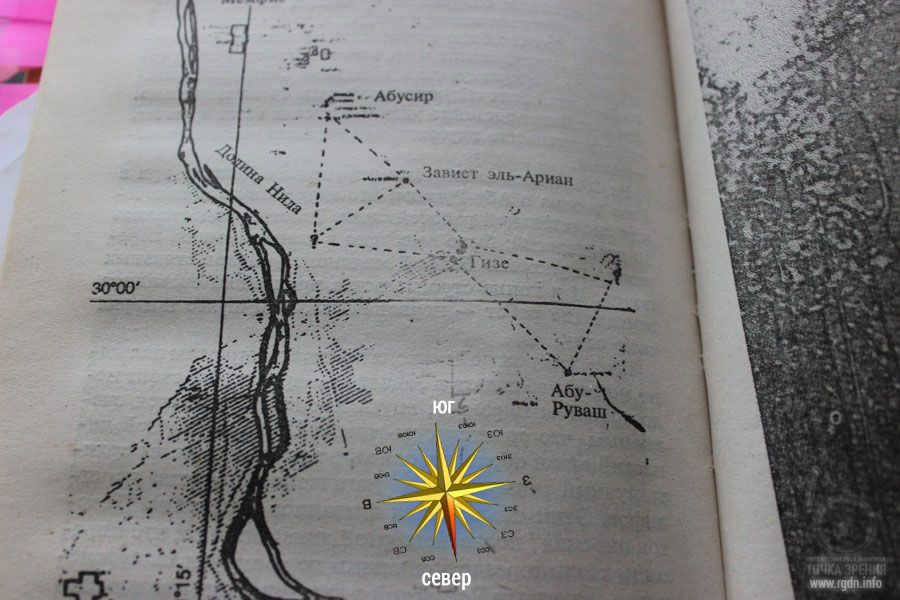
Along the same meridian (previously known as zero, Pulkovo, Alexandria), the pyramids of Giza can be found in company with Kiev.
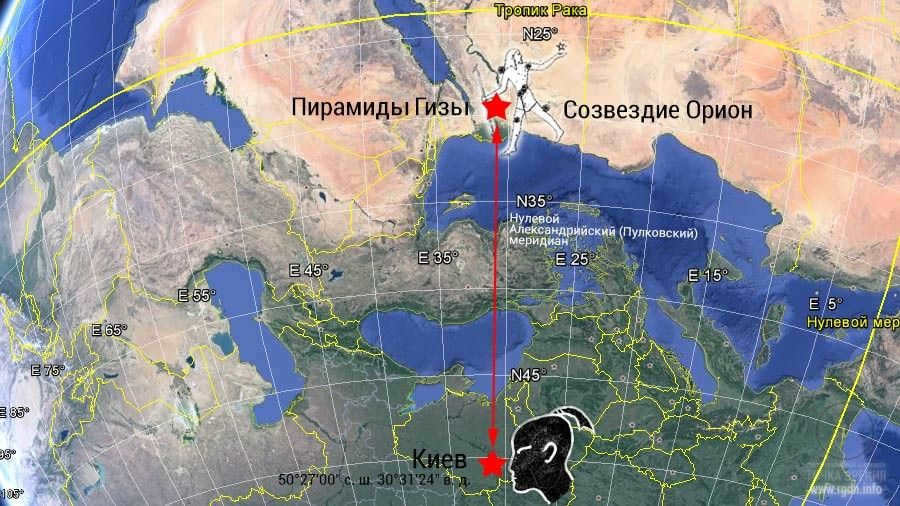
Aurore ✎ Admin 11.11.2017 22:19 Reply ↵
I have also come across fascinating depictions of the constellations in the northern hemisphere and ancient sanctuaries. You can find them at the following links: 1) First and 2) Second
These images showcase different representations of Orion (the hunter, with a rod). It is possible that in Kiev, there may be a similar projection of Orion in the sanctuaries, just like on the Kola Way and the pyramids of Crimea.
Moreover, there is a depiction of the Dragon constellation (Angkor Wat in Cambodia: https://rgdn.info/piramidy_mira._chast_9_ankor-vat_kambodzha). It’s fascinating to think about what would happen if the North Pole were to shift. There’s so much to explore!

Alexander N 10.11.2017 12:05 pm Reply ↵
There has been a significant amount of discussion regarding the Dogon and their understanding of the cosmos on this beloved website. Allow me to provide a brief summary of the information available online (which may be new to some). The decision to accept or reject this information is a personal one, but I believe there is a wealth of knowledge that aligns with the findings and conclusions discussed in various articles on this platform.
The Dogon, a relatively small African ethnic group, have historically resided and farmed in the Republic of Mali, specifically in the secluded mountainous area of Bandiagara. According to ancient Dogon tales, their forefathers migrated to this region in the 10th and 11th centuries from the upper regions of the Niger River, originating from the Manden territory in Sudan. This migration led to the displacement of the pre-existing Bandiagara population, resulting in the assimilation of their customs and potentially the adoption of their language.
Eric Guerrier’s 1975 book “Essays on Dogon Cosmogony: The Ark of Nommo” and Robert Temple’s 1976 book “The Mystery of Sirius” both attempted to interpret the Dogon myths. Temple went so far as to propose that the Dogon had received their knowledge from extraterrestrial beings from the Sirius system, potentially through ancient Egypt. Guerrier, an architect and amateur astronomer, pointed out that the Dogon’s cosmogonic system and their understanding of astronomy aligned with modern scientific findings and theories. This connection had been overlooked by ethnologists who lacked a comprehensive understanding of astronomy.
The celestial bodies are categorized by the Dogon as stars, planets, and satellites. They possess extensive knowledge of the solar system’s structure, understanding that the Sun rotates on its axis while the Earth orbits around the Sun. Interestingly, the Dogon also believe that Venus has a satellite, although this is not scientifically proven. Nevertheless, in 1976, astronomers Van Flandern and Harrington proposed a hypothesis suggesting that Mercury was once the satellite of Venus. Their calculations, based on meticulous astronomical observations and intricate computations, indicate that approximately 400,000 years ago Mercury transitioned to an independent orbit due to anomalies in its orbit and certain structural characteristics. The question of how the Dogon people acquired this knowledge remains an enigma.
The Dogon possess knowledge about Jupiter’s four satellites and Saturn’s ring, and they attribute them to the presence of elliptical orbits.
However, the primary role among the celestial bodies acknowledged by the Dogon tribe is Sirius. This fact is evident from the name they have given to this planet – “the navel of the world”. According to their mythology, Sirius is a triple star system. Nevertheless, modern astronomy classifies Sirius as a double system. It is relatively small in size, comparable to the Earth, yet it is an extremely hot star with a mass that is similar to that of the Sun, also known as a “white dwarf”. The second star completes one orbit around Sirius-A in 50.4 ± 0.09 Earth years. It is precisely with this periodicity that the Dogon tribe celebrates their mask festival. They, just like contemporary astronomical science, are aware that a small yet highly massive companion – referred to as “star Po” by the Dogon and known as Sirius-B by modern scientists – revolves around Sirius-A in an elongated orbit. The brightness of Sirius-B is 10,000 times fainter than that of the primary star, and it can only be observed through a powerful telescope. This star is invisible to the naked eye, leaving us to wonder how the Dogon tribe obtained such knowledge. Even more mysterious is the information provided by this tribe about another moon of Jupiter – the star Emme Ya, or in scientific terms, Sirius-C – which has yet to be discovered by contemporary science. According to the Dogon, this moon possesses an even more elongated orbit than Sirius-B, yet their periods of revolution are the same – 50 years. Additionally, the Dogon claim that the brightness of Sirius-A increases when Sirius-B approaches, a phenomenon that has also been confirmed by modern astronomers. This event occurs once every 50 years.
Dogon mythology holds that Sirius-B is the most massive star, so heavy that even if all humans were to combine their strength, they could not lift a small fragment of it. Modern astronomy confirms that Sirius-B, a white dwarf, is composed of a substance with incredible density, such that a single cubic centimeter of it would weigh about a ton on Earth. The Dogon people associate Sirius-B with the “po” grain, an “empty shell” that formed after the “dissemination of matter throughout the Universe”. This celestial body is considered the primary entity in the cosmos, responsible for the creation of spiral galaxies. In the scientific community, white dwarfs are believed to form from the explosive aftermath of supernovae events, which occur in stars that were previously red giants.
The Dogon people celebrate the Sigi holidays, which are associated with the star Sirius-A – Siri-Tolo, in a 50-year cycle. However, they actually celebrate this date every 60 years, and the festivities last for 7 years. This holiday is a time of renewal for the world. During Sigi, a large wooden bird mask called a “kanaga” is created. These masks are not destroyed at the end of the celebration, but are instead stored in a special location. This allowed scientists, including Griaule, to count the number of masks and determine that the Sigi celebrations began around 1300 AD.
According to the Dogon belief system, our planet Earth is not the only place where life exists. “The spiral-shaped star worlds are inhabited by living beings. Alongside the creations of Amma, which gave the world motion and form, various types of living creatures were also brought into existence.”
Dogon mythology also has knowledge of the minuscule particles that compose everything in our surroundings. “Every creation of Amma has its inception in the tiniest grain. Starting from that minuscule entity, all of Amma’s creations have been shaped through the gradual incorporation of similar components. Amma forms all things in small proportions, such as the ‘po’ grain, and subsequently integrates these grains into the preexisting entities. As Amma merges them, the body expands in size.”
The Dogon mythology also recounts the arrival of the initial inhabitants on Earth. The first extraterrestrial being to set foot on Earth was Ogo, one of the assistants of the almighty god Amma, who eventually rebelled against his benefactor. Ogo happens to be one of the four offspring of the first creature ever fashioned by the almighty god Amma, known as Nommo anagonno. This particular character, Ogo, is quite malevolent in nature. Amma made three attempts to prevent Ogo from reaching Earth, but Ogo cunningly constructed a vessel that relied on wind for propulsion. He hailed from the star Sigi-Tolo (Sirius). Subsequently, other settlers arrived on Earth, and Ogo commenced causing them harm. In response, the almighty god Amma transformed him into the “pale fox Yuruga”.
The following visitor, summoned by Amma, was Nommo. He was tasked with replenishing the population of the planet. Nommo arrived alongside humans in a vessel equipped with 60 chambers. The contents of only 22 of Nommo’s compartments were known to humans. The contents of the remaining chambers would be revealed at a later time. The Dogon people believed that this knowledge would revolutionize humanity’s perception of the world.
Nommo’s spacecraft traversed the void of space and descended upon Earth through a celestial portal created by the divine being Amma. It gracefully hovered in the atmosphere for a span of eight cycles, stretching across the entire expanse of the sky like a magnificent arch of vibrant hues. Its trajectory traced from the Eastern horizon to the Western horizon, occasionally inclining towards the North and South. Suspended from the heavens by a chain forged of pure copper, the ship was eventually returned to its celestial abode by Nommo. The precise location of its landing became Lake Debbie, a place of great significance. Accompanying Nommo were eight progenitors of humankind, each embarking on this momentous journey. Once safely on Earth, Nommo immersed himself in the waters, assuming the role of guardian and caretaker for all living beings. It is prophesied that Nommo shall reemerge on our planet on the sacred “day of the word.”
The Dogon records contain a fascinating account of Nommo’s arrival in the sky, accompanied by the appearance of a brilliant new star, five times brighter than Venus. One theory speculates that this could be an extraterrestrial spacecraft, while another suggests it may have been the result of a supernova in the Sirius system.
There are also indications that our Sun was once in the position of Sirius. Mentioned is Sirius C – the “Star of the Woman”, which is said to be the new center of the world. This knowledge reveals the theme of the Galactic system of Spiritual Suns or Cascades of Portals. It is understood that during the Quantum Transition, there will be a transfer of the Spiritual Suns of the Earth, and the Epoch of the Mother of the World will commence.
Perhaps, the Dogons are referring to the transition of the Spiritual Subjective Sun from Sirius A to Sirius C – the Female Star of the Mother of the World. This physical and spiritual process may coincide with the star’s collapse and transformation into a supernova. The energy released during such a supernova is sufficient to fuel the evolution of the entire solar system in the subsequent existence cycle. (At the moment of explosion, an amount of energy equivalent to the energy of all 250 billion stars in our galaxy combined is emitted into space.
combined.)
There is a theory suggesting that the Dogons originated from Sirius and arrived on Earth. They are known as the Guardians of the Codes, according to higher Powers. It has been documented that a sacred cave exists, housing artifacts from Sirius: the Alien Mummy, the Sirius Casket, the Dogons’ Crystal, and the Sacred Lake. This cave is situated within a mountain, which is in the shape of a Pyramid. The Dogons’ purpose is to transmit Sirius energy to Earth through their bodies, the Mummy, the Crystal, and the Pyramid. This energy is vital for Earth and humanity, but due to obstructions, the full extent of Siriusian energies cannot reach the Earth’s core. The Sirius Casket holds information about the repolarization and selestocalibration of Earth’s Pyramids. The aim is to “re-target” the Pyramids to new star positions for a successful Quantum Transition, as the sky will change after a pole shift. Celestocalibration does not involve physically rearranging the Pyramids, but rather depositing their ethereal Crystals. The Egyptian Pyramids were selestocalized by Priest-Devotees around 10,500 B.C., with the last polarity reversal occurring in 10,450 B.C. The notion that the Pyramid of Cheops aligns with Orion’s Belt, the Big Dipper, the Pleiades, and the constellation of Leo corresponds to the date often misinterpreted by Egyptologists as the Pyramids’ construction date. The Mirror of Dogon, a deep underground lake in a cave, serves as a Pyramid’s mirror, similar to a telescope. At certain times, this “telescope” enables the observation of all Three Stars within the Sirius system, along with their Planets and satellites!
There are additional tasks carried out by the Dogons. Naturally, the general public is unaware of their activities. Their actions are guided by their Higher Consciousness and Priests, with the Hogon being the chief among them. Within the underground sanctuary of the Dogon, a preserved Mummy similar to the one found beneath the third Sevastopol Pyramid in Crimea in February 2002 can be found. The Dogon Mummy contains “living” samples of Radiant 12-helix DNA. The brain of the Mumia belongs to the Reptoid progenitors of humanity. The Radiated DNA consists of 12 Mega-facets, which are further differentiated into Subspirals, Microspirals, and so on, in a hierarchical descending order. In total, humans possess 144,000 DNA helices. Each spiral corresponds to a hierarchical level in the Universe, including galaxies, constellations, stars, planets, asteroids, comets, moons, and more. Each DNA helix corresponds to one of the constellations in the Zodiac, the planets in the solar system, the groups of pyramids on Earth, and anything else connected to the dodecahedral scheme. The activation of latent DNA spirals occurs individually, with the concept of an optical or DNA star code. Each helix and subspiral in a specific person’s DNA is programmed to unlock under certain conditions, known as the Respiralization Key. The unlocking codes are specific selestorisuns, which are configural combinations of celestial bodies. When these codes align with the programmed code, the DNA helix opens up and blossoms like a flower. The third helix blossoms from the second, the fourth from the third, and so on. Each of the two active spirals contains six latent spirals, reflecting the universal principle of duality in the structure of human DNA. The Dogons also possess complete knowledge of the structural model of the current 2-helical DNA in humans, which mirrors the mutual trajectories of Sirius A and B. The crystal will be divided into fragments, corresponding to the population of the tribe – 246,000. Each fragment and tribe member corresponds to one of the 246,000 Places of Power on Earth, including 144,000 pyramids and 102,000 Places of Power such as Chakras, Subchakras, chakral branches, dolmens, and selestoimplantants. The pieces of the Dogon Crystal will scatter across the Earth, acting as relay magnets to receive and transmit Siriusian energy…
Yttrium 09.11.2017 22:42 Reply ↵
A fascinating number, 6500 years.
–Music
–Exploring my journal
–Sign up for email updates
–Loyal followers
–Online communities
–Statistics
Outer Space, the Milky Way!
In the past, it was widely believed that the Earth was the center of the universe. However, as time went on, this belief was proven to be incorrect, and the Sun was regarded as the center of everything. But even then, it was discovered that the Sun, which sustains all life on our planet, is just a minuscule speck in the vast expanse of stars. This expanse, known as the Milky Way, is not as immense as it appears from our perspective on Earth, and it only represents a small portion of the infinite Universe. Furthermore, it is likely just a small fragment of an even greater and more unimaginable entity that lies beyond our comprehension.


The Milky Way is disk-shaped
All the numerous star systems that make up the Milky Way are not scattered randomly in space, but instead they are organized in a massive structure resembling a disk with a bulge in the middle. The diameter of this disk is 100,000 light-years (equivalent to the distance light travels in a year, which is approximately 10¹³ km) or 30,659 parsecs (one parsec equals 3.2616 light-years). The disk has a thickness of several thousand light-years, and its total mass is 3 times 10¹² times the mass of the Sun. The mass of the Milky Way is comprised of stars, interstellar gas, dust clouds, and a halo that takes the form of a large sphere consisting of rarified hot gas, stars, and dark matter. Dark matter is believed to be a collection of hypothetical cosmic objects, accounting for 95% of the entire universe’s mass. These enigmatic objects are invisible and do not interact with modern detection technology. Their presence can only be inferred through their gravitational influence on visible groups of stars, which are limited in number for observation. Even with the most powerful telescope, the human eye can only perceive two billion stars. The remainder of the cosmic space is concealed by enormous, impenetrable clouds of interstellar dust and gas. The central thickening of the Milky Way’s disk is referred to as the Galactic center or nucleus. Within this region, billions of old stars move in highly elongated orbits. Their combined mass is estimated to be 10 billion times that of the Sun. The size of the core itself is not particularly remarkable, measuring 8,000 parsecs in diameter. The Galactic nucleus emits a brilliant glow, and if humans could observe it from Earth, they would see a massive luminous ellipsoid that is a hundred times larger than the Moon. Unfortunately, this awe-inspiring spectacle remains unseen due to the dense gas and dust clouds that obscure the Galactic center from our planet. Located 3,000 parsecs away from the Galaxy’s center is a gas ring that spans 1,500 parsecs and possesses a mass equal to 100 million solar masses. It is believed that this region serves as the central hub for new star formation. Additionally, there are gas arms extending approximately 4,000 parsecs from this ring. At the very heart of the core, there exists a black hole with a mass exceeding three million suns.

The limbs of our galaxy, the Milky Way
The structure of the galactic disk is not uniform. It contains distinct areas with high density, known as spiral arms. Within these arms, new stars continue to form, and the arms themselves curve around the core in a semicircular shape. Currently, there are five main arms: the Swan arm, the Perseus arm, the Centauri arm, the Sagittarius arm, and the arm of Orion, which is where the solar system is located. The solar system is approximately 28,000 light-years away from the galactic core. The Sun and its planets orbit around the center of the Galaxy at a speed of 220 km/s, completing a full rotation every 220 million years. However, there is another figure of 250 million years. The solar system is positioned just below the galactic equator and its orbit is not smooth or steady, but rather bounces. Every 33 million years, it crosses the galactic equator and rises above it by a distance of 230 light-years, only to fall back down and repeat this ascent at another interval of 33 million years. The galactic disk spins, but not as a single entity. The core rotates faster, while the spiral arms within the disk rotate at a slower pace. This raises the question of why the spiral arms maintain their shape and configuration for 12 billion years (the estimated age of the Milky Way) without twisting around the center of the Galaxy. One theory explains this phenomenon by considering the spiral arms as density waves that arise on the galactic background, rather than material objects. These waves are caused by the formation of stars and the birth of highly luminous stars. In other words, the rotation of the spiral arms is not influenced by the movement of stars along their galactic orbits. Instead, stars either pass through the arms at a faster speed if they are closer to the Galactic center, or lag behind if they are located in the outer regions of the Milky Way. The shape of the spiral waves is determined by the brightest stars, which have short lifespans and remain within the arm. As evident from the information above, the Milky Way is a complex cosmic structure that extends beyond the surface of the disk. It is surrounded by a large spherical cloud known as the halo. The halo consists of rarefied hot gases, individual stars, globular star clusters, dwarf galaxies, and dark matter. Dense gas clouds are also found in the outer regions of the Milky Way, spanning several thousand light-years in length and having a temperature of 10,000 degrees Celsius. These clouds have a mass equivalent to at least ten million suns.

The Andromeda Galaxy
In the vast expanse of the Universe, the Milky Way is not alone. There is another immense star system located 772 thousand parsecs away from it. This star system is known as the Andromeda Galaxy (or, more romantically, the Andromeda Nebula.) Since ancient times, it has been referred to as “a small celestial cloud, easily visible in the dark night”. In the early 17th century, astronomers with religious inclinations believed that “in this place, the crystal solid is thinner than usual, allowing the light of the kingdom of heaven to pour through”. The Andromeda Nebula is the only galaxy visible to the naked eye in the sky. It appears as a small oval shining spot, with unevenly distributed light, with the central part being brighter. With the aid of a telescope, this spot transforms into a colossal star system with a diameter of 150 thousand light years, surpassing the Milky Way in size. However, it is not just the size that sets Andromeda apart from the galaxy in which our solar system exists. In 1991, the planetary camera of the Hubble Space Telescope detected the presence of two nuclei. One of these nuclei is smaller and orbits around the larger and brighter nucleus, gradually collapsing due to the tidal forces exerted by the latter. This slow agony of one of the nuclei suggests that it is a remnant of another galaxy that was absorbed by Andromeda. Many may be unpleasantly surprised to discover that the Andromeda Nebula is moving towards the Milky Way, and consequently, our Solar System. The approach speed is approximately 140 kilometers per second. As a result, the encounter between these two star giants will occur in approximately 2.5-3 billion years. It will not be a meeting on Elba, nor will it be a cosmic catastrophe on a global scale. The two galaxies will simply merge into one. However, the question of which galaxy will dominate leans in favor of Andromeda, as it possesses greater mass and has experience in absorbing other galactic systems. As for our solar system, various predictions exist. The most pessimistic suggests that the Sun, along with all the planets, will be expelled into intergalactic space, finding no place in the new formation. Perhaps, though, this outcome is for the best. After all, it is evident that the Andromeda Galaxy is a bloodthirsty monster, devouring its own kind. Having consumed the Milky Way and destroyed its core, the Nebula will transform into a colossal Nebula and continue its journey through the vastness of the Universe, consuming more and more galaxies along the way. The ultimate result of this journey will be the collapse of an immensely swollen, super giant star system. The Andromeda Nebula will disintegrate into countless small stellar formations, mirroring the fate of vast empires of human civilization, which grew to unprecedented sizes before crumbling under the weight of their own greed, self-interest, and hunger for power. However, it is best not to fill our minds with thoughts of impending tragedies. Instead, let us gaze upon another galaxy known as the Triangle Galaxy. It resides in the expanses of the Universe, approximately 730 thousand parsecs away from the Milky Way. It is twice the size of the Milky Way and has a mass at least seven times smaller. In other words, it is an ordinary medium-sized galaxy, of which there are many in the cosmos. All three of these star systems, along with several dozen other dwarf galaxies, are part of the so-called Local Group. of the Virgo Supergroup, a massive star formation spanning 200 million light years. The Milky Way, the Andromeda Nebula, and the Triangle Galaxy share many similarities. They are all spiral galaxies with flat disks composed of young stars, scattered star clusters, and interstellar matter. Each disk features a central bulge. The most notable feature, however, is the presence of bright spiral arms containing numerous young and hot stars. The nuclei of these galaxies also bear resemblance, consisting of clusters of old stars and gas rings where new stars are born. A constant characteristic of each nucleus is the presence of a black hole with an enormous mass. It has already been mentioned that the black hole in the Milky Way corresponds to over three million solar masses. Black holes are one of the most enigmatic phenomena in the Universe. While they are observed and studied, these mysterious entities are not eager to reveal their secrets. It is known that black holes possess incredibly high density, and their gravitational field is so powerful that even light cannot escape from them. Any cosmic body that enters the zone of influence of a black hole (known as the event horizon) will be immediately “swallowed” by this formidable universal monster. The fate of the “unfortunate” victim within a black hole remains unknown. In short, entering a black hole is easy, but escaping from it is impossible.

Black hole
Astrophysicists have long been fascinated by the enigmatic objects known as black holes. These cosmic formations, which are invisible to the naked eye, have such strong gravitational pull that nothing, not even light, can escape them. The image above depicts an artistic representation of a black hole, showcasing its immense power and mysterious nature.
In the vast expanse of the cosmos, there are numerous black holes scattered, some of which have a mass that far exceeds the mass of the black hole at the center of the Milky Way. However, this does not imply that the “native” monster of our solar system is any less dangerous than its larger counterparts. It is just as insatiable and bloodthirsty, appearing as a compact source of X-rays with a diameter equivalent to 12.5 light hours. This enigmatic object is known as Sagittarius A. Its mass has been measured to be over 3 million times the mass of the Sun, and its gravitational pull extends up to 68 astronomical units (1 astronomical unit being the average distance between the Earth and the Sun). Within this boundary lies the realm of its bloodthirstiness and treachery towards various celestial bodies that dare to cross it. Some may mistakenly believe that this tiny creature is satisfied with random victims, but this is far from the truth. It has a constant source of power in the form of the star S2, which orbits the black hole in a compact orbit, completing one revolution every 15.6 years. The maximum distance between S2 and the monstrous black hole is 5 light days, while the minimum is a mere 17 light hours. Under the influence of the black hole’s tidal forces, the doomed star is ripped apart, with parts of its matter hurtling towards the insatiable cosmic abyss at incredible speeds. As it approaches, the matter transforms into red-hot plasma, emitting a brilliant glow before disappearing forever into the invisible abyss. But that’s not all – the black hole’s cunning knows no bounds. It is accompanied by another, smaller and less dense black hole, whose task is to drive stars, planets, interstellar dust, and gas clouds towards its more powerful counterpart. All of these objects also turn into plasma, emitting bright light before vanishing into nothingness. However, despite the evidence and the gory interpretation of events, not all scientists agree on the existence of black holes. Some argue that they are, in fact, unknown masses trapped beneath a cold and dense shell. These masses possess an enormous density, exerting incredible force on the surface, compressing it from within. This formation is known as a gravastar – a gravitational star. This concept attempts to explain the expansion of the entire universe by fitting it into such gravastars. Proponents of this idea argue that outer space is a gigantic bubble inflated by an unknown force. In other words, the entire cosmos is a vast gravastar, within which smaller gravastar models coexist, periodically absorbing individual stars and other formations. The absorbed bodies are then ejected into other cosmic spaces, which are essentially invisible as they emit no light from beneath their completely black shells. Perhaps these gravastars represent other dimensions or parallel worlds? The concrete answer to this question will remain elusive for a long time. However, the presence or absence of black holes is not the only topic occupying the minds of space researchers. Far more intriguing and captivating are thoughts about the existence of intelligent life in other star systems within the universe. The Sun, which provides life to Earth, is just one among countless other suns in the Milky Way. Its disk appears as a faintly glowing band encircling the celestial sphere when observed from Earth. These distant billions and billions of stars include many with their own planetary systems. Could there not be at least one among these countless planets that harbors intelligent beings – our intellectual brethren? It is reasonable to assume that life similar to that on Earth could develop on a planet orbiting a star of the same class as the Sun. One such star exists in the sky, and it happens to be part of the closest star system to our own. This star is Alpha Centauri A, located in the Centaurus constellation. It is visible to the naked eye from Earth, and its distance from the Sun is 4.36 light years. It would indeed be marvelous to have intelligent neighbors so close by. However, wishes do not always align with reality. With current technological advancements, the task of detecting signs of extraterrestrial civilization, even at distances of 4-6 light years, remains quite challenging. Therefore, it is premature to assert the existence of any intelligent life in the Centaurus constellation. At present, the only means available to reach out to the cosmos is through radio signals, in the hope that some unknown entity will respond to the call of human intelligence. Since the early 20th century, the world’s most powerful radio stations have persistently and tirelessly engaged in such endeavors. Consequently, the Earth’s radio emissions have significantly increased, distinguishing our blue planet from all other planets in the solar system. These signals from Earth cover a radius of at least 90 light years in space. In the grand scale of the universe, this is a mere drop in the ocean. However, as the saying goes, every little bit helps. If there is indeed a highly advanced intelligent life somewhere far, far away in the cosmos, it will eventually take notice of the heightened radiation background within the depths of the Milky Way, as well as the radio signals emanating from there. Such an intriguing phenomenon will not escape the curiosity of inquisitive extraterrestrial minds. Consequently, the active search for signals from outer space continues. Yet, the dark abyss remains silent, indicating that there are most likely no intelligent beings within the Milky Way ready to establish contact with Earth’s inhabitants, or their technological development is still at a very primitive stage. However, another possibility arises, suggesting that a highly advanced civilization, or civilizations, do exist, but they are sending other signals into the vastness of the galaxy that our earthly technology cannot detect. Progress on our blue planet continues to advance and improve. Scientists are developing new and diverse methods of transmitting information over long distances. All of this holds the potential for positive outcomes. However, we must not forget that the universe is boundless. There are stars whose light takes billions of years to reach Earth. In essence, when we observe such a celestial object through a telescope, we are witnessing a snapshot of the distant past. It is entirely possible that the signal received by Earthlings from the cosmos could be the voice of a long-extinct extraterrestrial civilization that existed during a time when neither the solar system nor the Milky Way had yet come into existence. The response from Earth will reach beings who were not even conceived at the time the message was sent. Nevertheless, the laws of harsh reality must be taken into account. In any case, the search for intelligence in distant galactic worlds must continue. If the current generation is not fortunate, future generations may be. Hope in this regard shall never wane, and persistence and perseverance will undoubtedly yield great rewards. The exploration of galactic space is a very real and imminent possibility. In the next century, fast and elegant spaceships will journey to the nearest constellations. Astronauts aboard these ships will gaze out of their windows at the entire solar system, rather than just the planet Earth. They will behold it as a distant, radiant star. However, this will not be the cold, soulless glow of one of the countless suns of the galaxy, but the familiar radiance of our Sun, around which our beloved Mother Earth gracefully revolves, invisible yet comforting. Soon enough, the dreams of science fiction writers, as depicted in their works, will become everyday reality. A journey along the Milky Way will be as mundane and uneventful as a subway ride from one end of Moscow to the other. This article was written by ridar-shakin
Where does the boundary between space and the Universe lie? The answer to this question varies depending on how one defines space and how many universes one considers.
Atmosphere
The Karman line, located approximately 100 km above the Earth’s surface, is considered the “official” boundary separating the atmosphere from space. This specific altitude was chosen not only for its simplicity, but also because the air density at this height is so low that no aircraft can remain airborne solely by aerodynamic forces. To generate enough lift, a vehicle would need to attain the first cosmic speed. At this altitude, wings are no longer necessary, marking the transition from aeronautics to astronautics.
However, the planet’s atmospheric shell does not abruptly terminate at an altitude of 100 kilometers. The outer portion, known as the exosphere, actually stretches out to about 10 thousand kilometers. In this region, the exosphere is primarily composed of scarce hydrogen atoms, which have the ability to effortlessly escape from it.
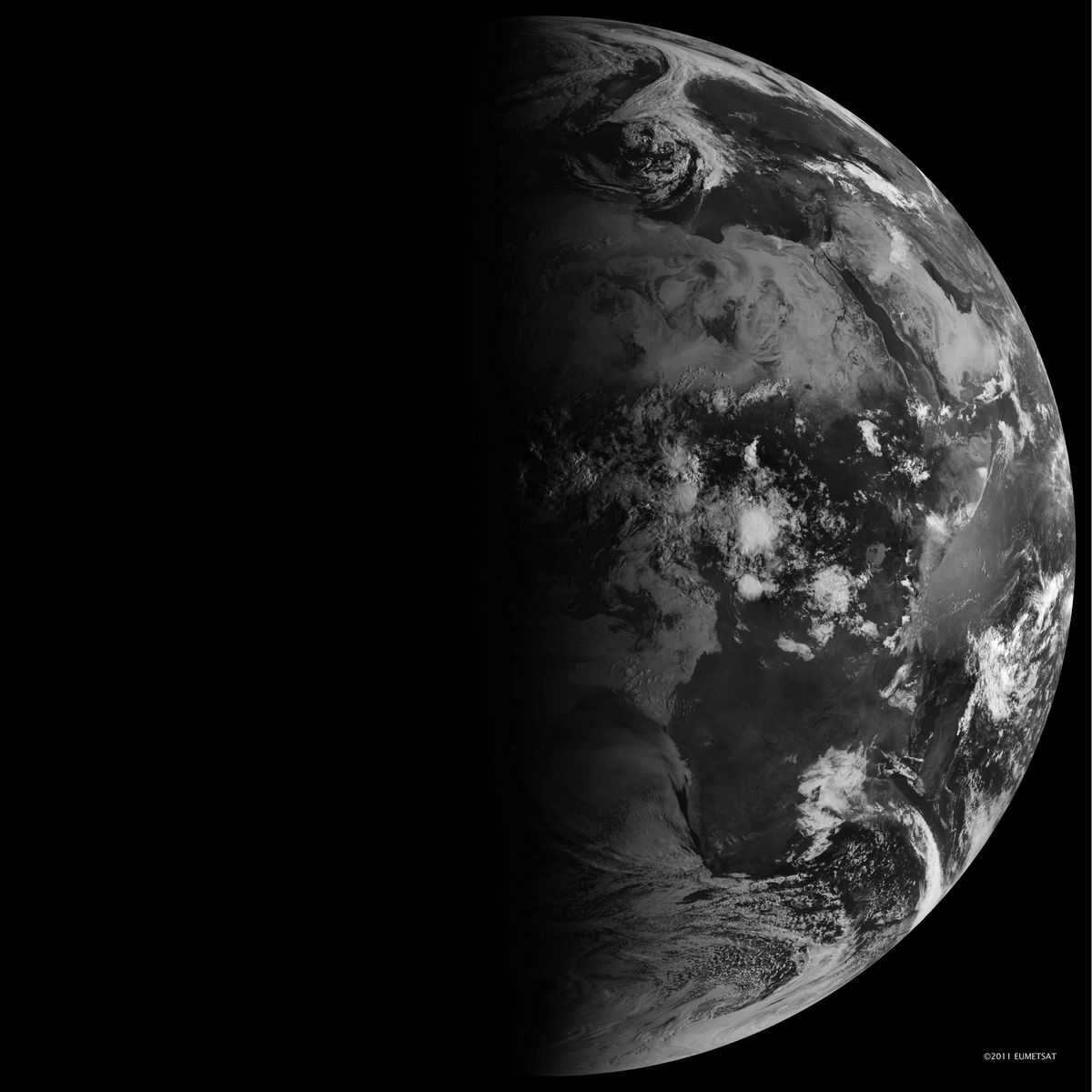
Solar system
It is common knowledge that the plastic models of the solar system that we are familiar with from school do not accurately represent the actual distances between the sun and its planets. The purpose of the school model is simply to ensure that all the planets can fit on the display. In reality, the scale is much larger than that.
Therefore, the focal point of our framework is the Sun, a massive star measuring nearly 1.4 million kilometers in diameter. The planets in closest proximity to it – Mercury, Venus, Earth, and Mars – constitute the inner portion of the solar system. Each of these planets possesses a limited number of natural satellites, is composed primarily of solid minerals, and (with the exception of Mercury) has its own atmosphere. By convention, the demarcation line for the inner section of the solar system can be delineated along the Asteroid Belt, situated between the orbits of Mars and Jupiter, approximately two to three times the distance from the Sun as the Earth.
It is a domain of colossal planets and their numerous moons. And the initial of these is, certainly, the massive Jupiter, positioned about five times further from the Sun than the Earth. It is succeeded by Saturn, Uranus, and Neptune, the gap to which is already staggeringly large – over 4.5 billion kilometers. From here to the Sun is already 30 times further than from the Earth.
If we compress the Solar System to the proportions of a soccer field with the Sun as the goal, Mercury would be 2.5 meters from the end line, Uranus would be at the opposite gate, and Neptune would already be somewhere in the nearest parking lot.
The farthest galaxy that astronomers have been able to observe from Earth is z8_GND_5296, which is situated approximately 30 billion light years away. However, the most distant entity that can theoretically be observed is the relic radiation, which has been preserved since the Big Bang.
Enclosed within this sphere of the observable Universe are over 170 billion galaxies. Just imagine: if these galaxies were suddenly transformed into peas, they would be able to fill an entire stadium. The number of stars within these galaxies is in the hundreds of sextillions (thousands of billions). This vast expanse spans 46 billion light-years in all directions. But what lies beyond it – and where does the Universe come to an end?
Actually, the question of the size of the whole Universe remains unanswered – it could potentially be boundless. It is also possible that there exist other Universes beyond its confines, but the nature of their connection and their composition is a rather elusive narrative, which we will eventually share with you.
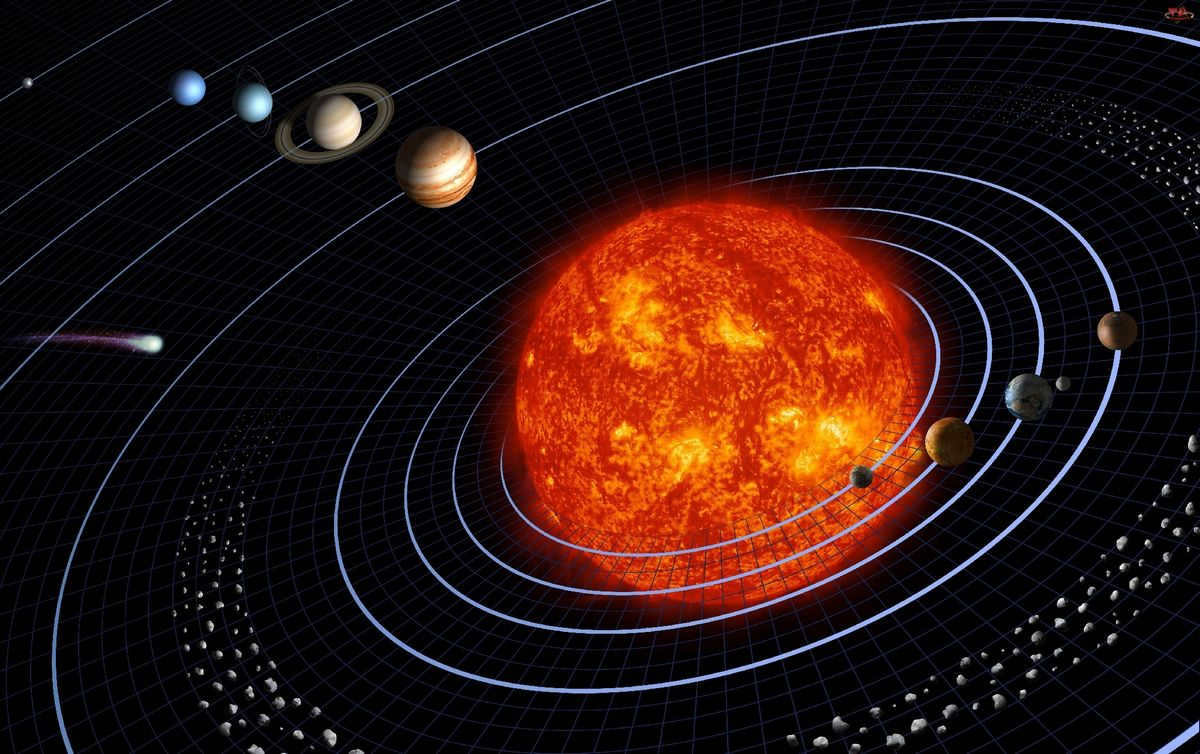
Belt, cloud, sphere
Pluto, as we are aware, has lost its status as a full-fledged planet and has transitioned into the category of dwarf planets. This category includes nearby Erid, Haumea, other minor planets, and Kuiper Belt objects.
This region is extremely distant and vast, extending from 35 astronomical units from Earth to the Sun, and even up to 50. It is from the Kuiper Belt that short-period comets migrate towards the inner regions of the solar system. If we were to imagine our soccer field, the Kuiper Belt would be situated a few blocks away. However, even in this distance, it is still considered a significant distance from the boundaries of the solar system.
The Oort Cloud is a hypothetical region located at a significant distance from Earth. Despite its distance, there is substantial indirect evidence suggesting the existence of a vast collection of icy bodies, known as the Oort Cloud, located approximately 50-100 thousand times farther from the Sun than our own position. These icy objects are believed to be the source of long-period comets that occasionally travel towards Earth. To put this immense distance into perspective, it is equivalent to a full light-year, which is a quarter of the distance to the nearest star. In terms of scale, it is comparable to being thousands of kilometers away from the goal in a soccer field analogy.
It is worth noting that the Sun’s gravitational influence extends even beyond the Oort Cloud. The outer boundary of the Oort Cloud, known as the Hill sphere, is located a staggering two light-years away from the Sun.
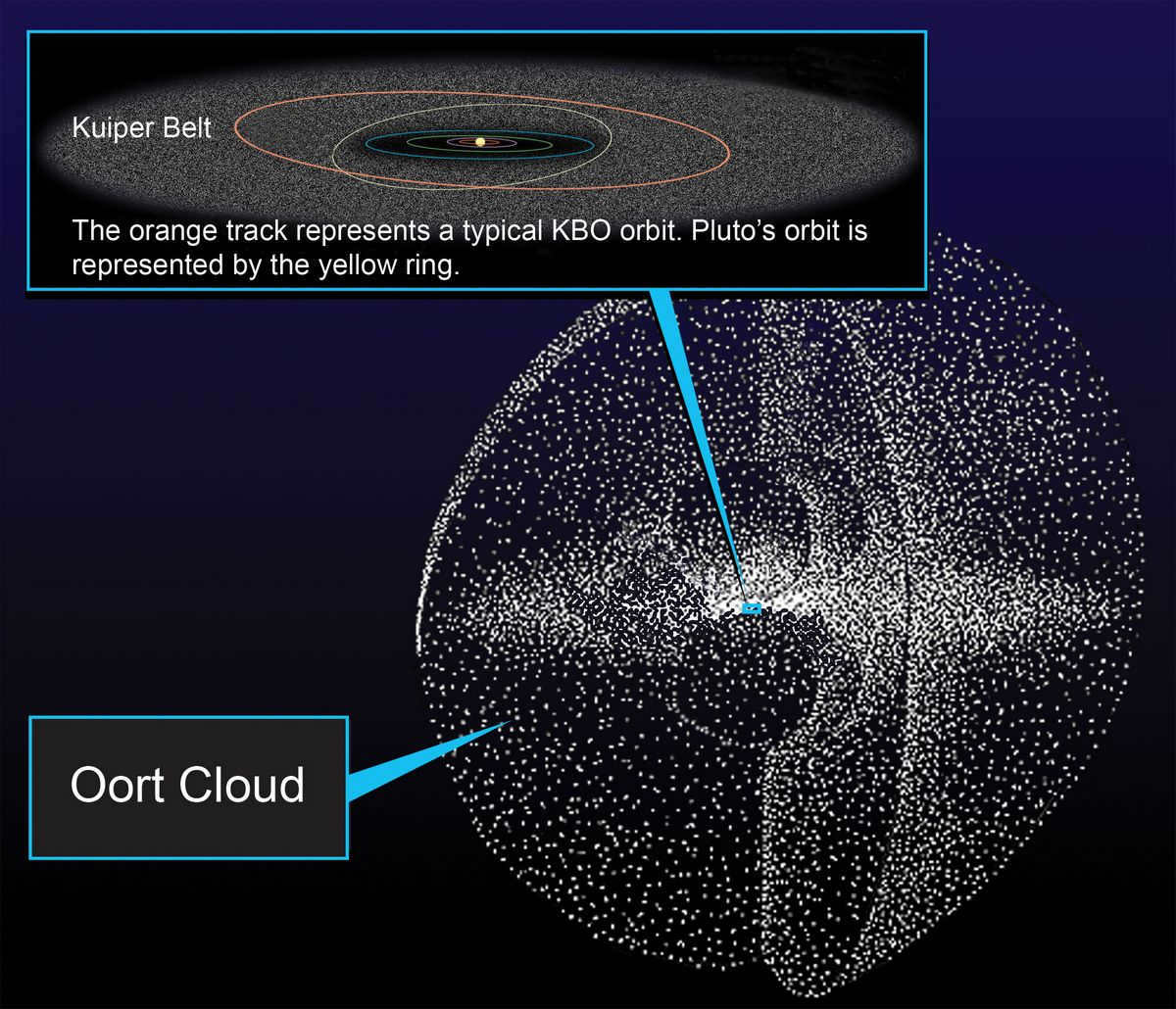
Heliosphere and heliopause
It’s important to keep in mind that all of these boundaries are somewhat arbitrary, much like the Karman line. Instead of the Oort cloud, the region where the pressure of the solar wind gives way to interstellar matter – the edge of its heliosphere – is considered the conditional boundary of the solar system. The first indications of this can be observed at a distance approximately 90 times greater from the Sun than the Earth’s orbit, at what is known as the shock boundary.
The heliopause, located 130 astronomical units away, serves as the ultimate destination for the solar wind. So far, only two probes, the American Voyager-1 and Voyager-2, dispatched in the 1970s, have traversed this vast distance. These spacecrafts hold the record as the most distant man-made objects in existence. Just last year, they successfully crossed the shock wave boundary, providing scientists with intermittent transmissions of valuable data, which are eagerly monitored back on Earth.
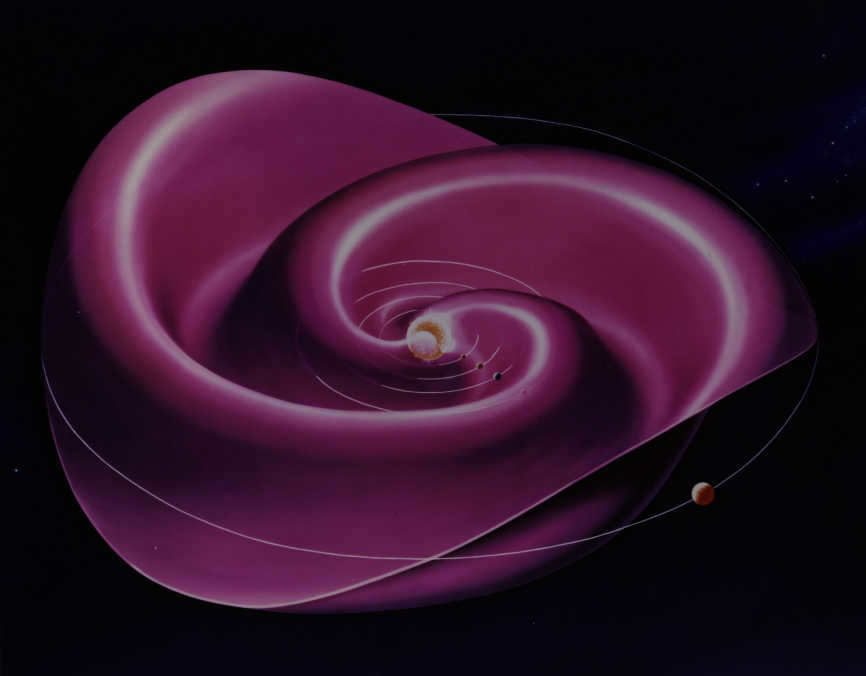
A Secret Hidden in the Galaxy’s Sleeve
All of this – including our planet Earth, Saturn with its majestic rings, the icy comets of the Oort cloud, and even the mighty Sun itself – is hurtling through the vast expanse of the Local interstellar cloud. This rarefied cloud acts as a protective shield, guarding us from the solar wind. Beyond the boundary of the shock wave created by the cloud, particles hardly manage to penetrate.
When dealing with such immense distances, comparing them to a soccer field becomes rather inconvenient. Instead, we turn to more scientific measurements of length, such as the light-year. The local interstellar cloud extends for approximately 30 light-years, and within a few tens of thousands of years, we will venture beyond its borders and enter the neighboring (and larger) G-cloud. It is within the G-cloud that our neighboring stars, such as Alpha Centauri, Altair, and others, are currently located.
All of these clouds originated from multiple ancient supernova explosions that gave rise to the Local Bubble, through which we have been traversing for at least the past 5 billion years. This bubble extends for 300 light years and is situated in the Orion arm, one of several arms of the Milky Way. Despite being smaller in comparison to the other arms of our spiral galaxy, its dimensions are significantly larger than that of the Local Bubble: spanning over 11,000 light-years in length and 3,500 light-years in width.
Visual depiction of the Local Bubble (White) alongside the adjacent Local Interstellar Cloud (pink) and a portion of Bubble I (green).

Location of the Solar System in the Milky Way
The center of our galaxy is located 26 thousand light years away from the Sun, while the diameter of the entire Milky Way is 100 thousand light years. Our solar system, including the Sun and Earth, is positioned on the outer edge of the galaxy. It is part of a group of neighboring stars that orbit around the center of the Milky Way, completing a full rotation every 200-240 million years. Interestingly, during the time of the dinosaurs on Earth, our solar system was on the opposite side of the galaxy!
The Milky Way is surrounded by two powerful arms – the Magellanic Stream, which consists of gas drawn from the neighboring dwarf galaxies (the Large and Small Magellanic Clouds), and the Sagittarius Stream, which contains stars that have been torn away from another dwarf neighbor. Our galaxy is also associated with several small globular clusters, and it is part of the gravitationally bound Local Group of galaxies, which consists of approximately fifty galaxies.
The closest galaxy to us is the Andromeda Nebula. It is several times larger than the Milky Way and contains approximately a trillion stars. It is located 2.5 million light years away from us. The boundary of the Local Group is located at an unimaginable distance: its diameter is estimated to be a megaparsec – to traverse this distance, light would require approximately 3.2 million years.
However, the Local Group is overshadowed by a vast structure measuring approximately 200 million light-years in size. This remarkable structure is known as the Local supergroup of galaxies, encompassing around one hundred similar groups and clusters of galaxies, along with tens of thousands of individual galaxies that are arranged in elongated chains, resembling filaments. Beyond this point lies only the outermost reaches of the observable Universe.
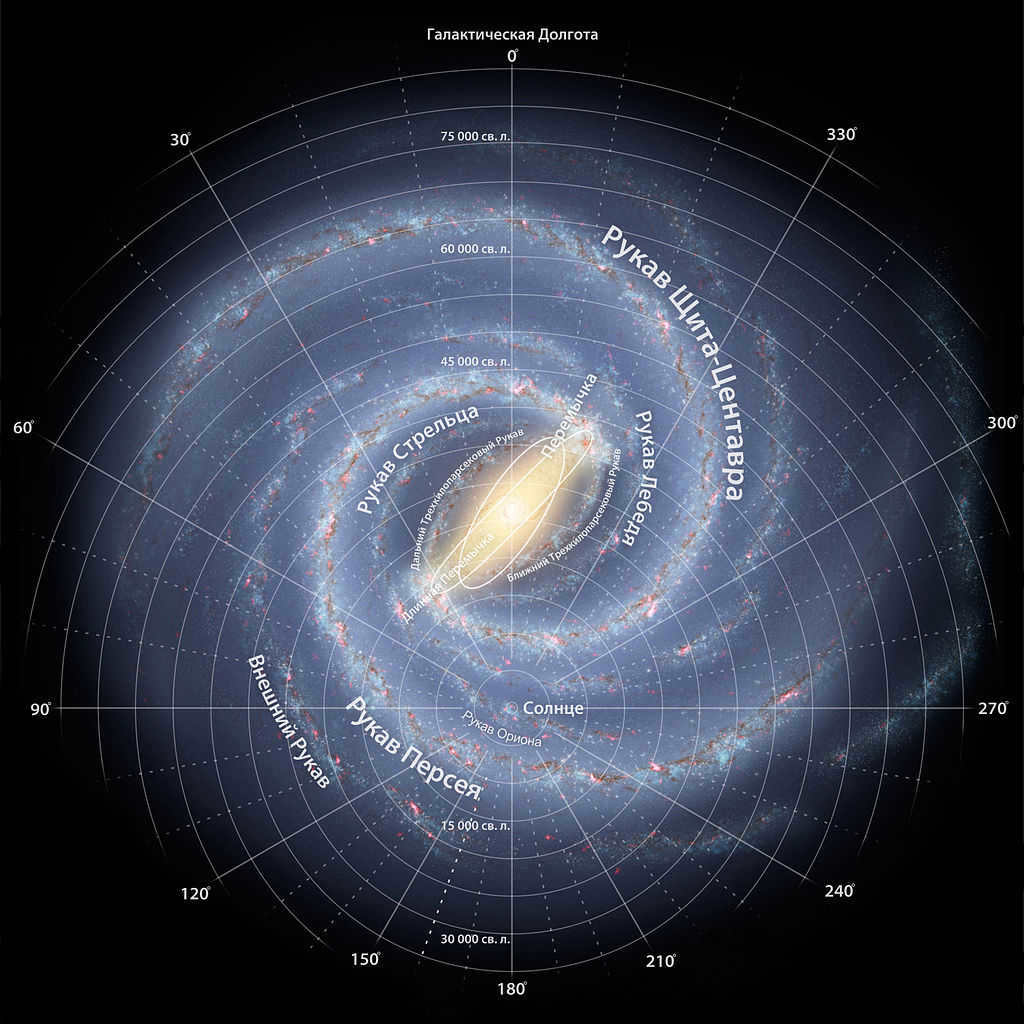
What Lies Beyond the Universe?
We all know that the plastic models of our solar system that we encountered in school fail to accurately represent the vast distances between a star and its planets. These models are designed to fit on a stand and therefore do not provide an accurate depiction of the true scale of the universe.
Therefore, the Sun serves as the focal point of our solar system, being a massive star with a diameter of approximately 1.4 million kilometers. Occupying the innermost region of the solar system are the planets Mercury, Venus, Earth, and Mars. Each of these planets possesses a limited number of natural satellites, consists primarily of solid minerals, and, with the exception of Mercury, possesses an atmosphere. By convention, one can delineate the boundary of the inner region of the solar system along the Asteroid Belt, which is situated between the orbits of Mars and Jupiter and is approximately 2-3 times farther from the Sun than Earth.
In this realm, we find the immense giants of the planets and their vast array of satellites. Leading the pack is the colossal Jupiter, positioned approximately five times farther from the Sun than our home planet, Earth. Following suit are Saturn, Uranus, and Neptune, each separated by mind-blowing distances exceeding 4.5 billion kilometers. At this point, the Sun is already a staggering 30 times more distant than our Earth.
To put the scale of our Solar System into perspective, let’s imagine it as a soccer field, with the Sun as the goal. In this scenario, Mercury would be a mere 2.5 meters from the outermost line, Uranus would be situated at the opposing goal, and Neptune would find itself somewhere in the closest parking lot.
Astronomers have managed to observe the most distant galaxy from Earth known as z8_GND_5296, which resides a staggering 30 billion light years away. However, the most remote object that can theoretically be observed is the relic radiation, which has been preserved since the inception of the universe, otherwise known as the Big Bang.
There are over 170 billion galaxies within the observable Universe. To put this into perspective, if each galaxy were to transform into a pea, they would be able to fill an entire stadium. The number of stars within this vast expanse is in the hundreds of sextillions (thousands of billions). The Universe spans an unimaginable distance of 46 billion light-years in every direction. However, the question remains: what lies beyond this immense expanse and where does the Universe come to an end?
Strangely enough, there is no definitive answer to this question. The true size of the entire Universe remains unknown, with the possibility that it may be infinite. Additionally, it is also possible that there are other universes that exist beyond its borders. The nature of these neighboring universes and their relationship to our own is still a vague and uncertain tale that we cannot fully comprehend.
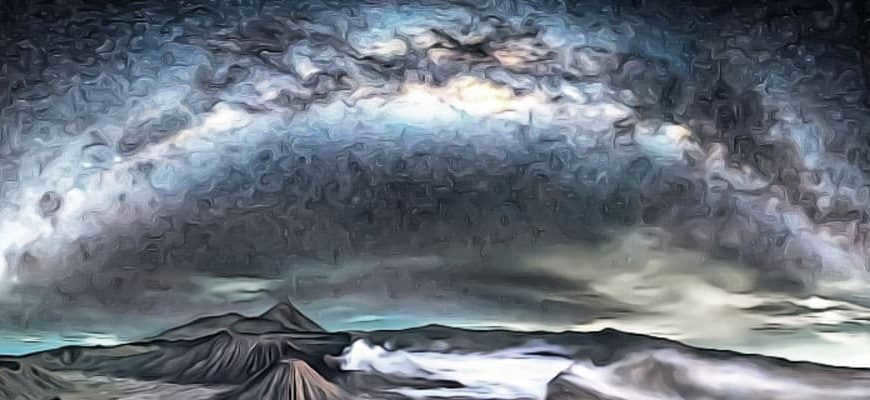
It is common knowledge that the Milky Way is a spiral galaxy. It is universally acknowledged among astronomers that our residence is in a spiral galaxy with a junction. This galaxy possesses an elliptical core, rather than a spherical one.
Our galaxy is also characterized by the presence of what we refer to as “spiral arms”. And, interestingly enough, the exact number of these arms is still unknown to the scientific community! It is truly astonishing to think about. Even though astronomers have delved billions of light years into the vast depths of the Universe, they have yet to fully comprehend the intricate structure of their very own galaxy! However, this is not entirely surprising. The reason for this is that our solar system is situated within the galactic disk, at a distance of approximately 27,700 light-years from its center. This positioning makes it impossible for us to directly observe and ascertain the true composition of the Milky Way. The galactic disk effectively conceals the entirety of its structure from our view. So how then can we even begin to unravel this mystery?
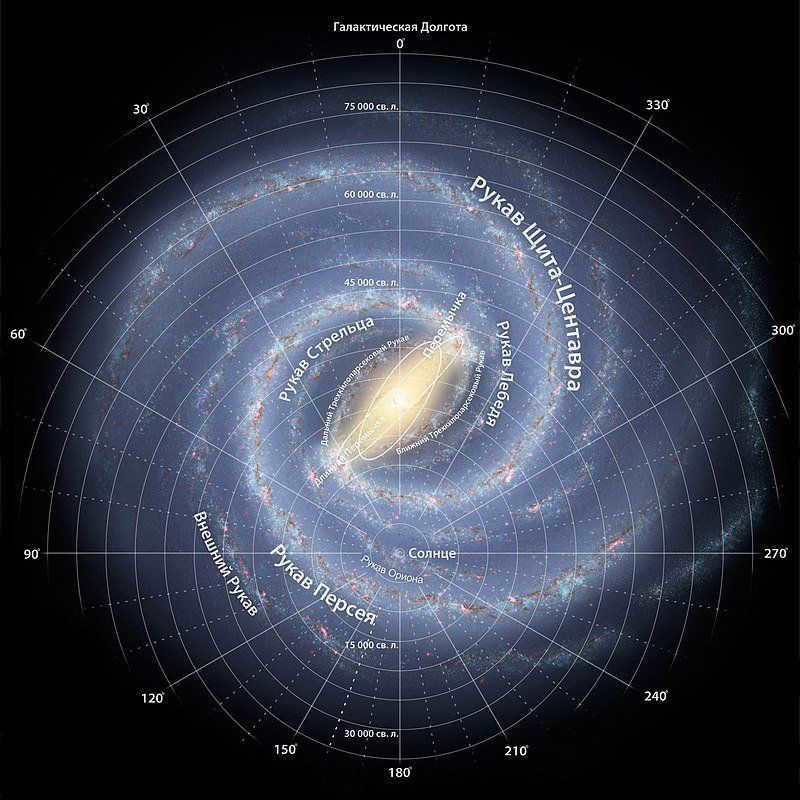
Locating the Solar System within the Galaxy
To find the exact position of our Solar System within the Milky Way Galaxy, scientists have had to rely on methods that go beyond visible light. The interstellar dust in the galaxy blocks visible light, making it difficult to see towards the center of the galaxy. However, radio waves are able to penetrate through this interstellar medium, allowing astronomers to map the distribution of hydrogen in the galaxy. Hydrogen is the most abundant element in the universe, and it emits radio waves at specific wavelengths when in its cold state.
By studying the distribution of neutral hydrogen in the galaxy using radio observations, scientists have been able to identify the spiral arms of the Milky Way. This information has been sourced from open scientific literature.
Density waves in the form of spiral arms are responsible for perturbing the interstellar medium within galaxies. Contrary to popular belief, the arms themselves do not physically move; rather, it is the matter within the galactic disk that undergoes motion. As this matter traverses through the arms, it undergoes compression, resulting in an increase in density. Consequently, this heightened density leads to a greater rate of star formation. Hence, spiral arms serve as notable regions within galaxies where numerous stars are born. The birth of stars can be likened to a chain reaction, as young blue stars, through their supernova deaths, trigger the formation of new star clusters, which in turn give rise to more young stars.
Blue giant stars emit ultraviolet light that ionizes the interstellar medium, leading to the creation of stunning emission nebulae. These nebulae also aid in delineating the location of the spiral arms.
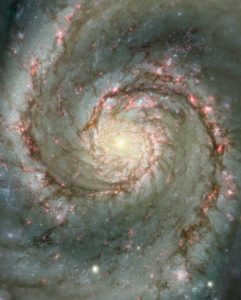
The study of the distribution of young stars is the most effective method for determining the structure of the spiral arms of our Galaxy. As mentioned earlier, astronomers are unable to observe these phenomena in the visible range. Therefore, they must observe the Galaxy using the infrared or microwave spectrum to address this challenge.
Mapping the Galaxy
Astronomers have been engaged in the process of mapping the Galaxy for many years, utilizing various techniques. Galactic mapping is a highly meticulous and time-consuming discipline. However, during the 1980s, scientists were able to determine that the Milky Way consists of three distinct arms. These arms include the Orion arm, where our Sun resides, the Perseus arm, which is located further away from the galactic center than us, and the Sagittarius arm, which is positioned closer to the center of the Galaxy. Later on, researchers discovered evidence of two additional arms when they reached the furthest distance from the nucleus of the galaxy. These newly identified arms were named the Shield-Centaurus arm and the Outer Arm.
The subsequent inquiry aimed to comprehend the overarching structure of the Galaxy. Despite astronomers’ ability to perceive the galactic disk via infrared or radio waves, their vantage point in space imposes certain limitations. Moreover, certain galactic areas inevitably elude observation altogether.
Furthermore, there are instances when galaxy arms coil around the nucleus multiple times, giving rise to inquiries. For instance, is the Perseus arm identical to the Sagittarius arm? Or is it, in fact, an extension of the Outer Arm?
What is the true nature of our Milky Way?
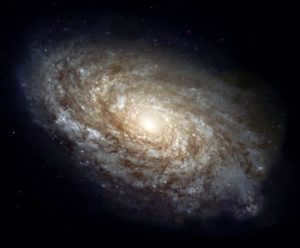
A complicated past
Scientists have divided into two factions: the “two arms” and the “four arms”. This terminology clearly refers to the number of spiral arms suggested by each faction. Initially, the majority of scientists supported the hypothesis of four arms. However, in 2008, observations of stars conducted using NASA’s advanced infrared space telescope “Spitzer” unexpectedly shifted the balance in favor of the two-arm hypothesis.
In consequence, the well-known Perseus arm and the Shield-Centaur arm were designated as the primary arms originating from the extremities of the central junction of our Galaxy. The remaining arms were considered secondary in nature. A consensus was achieved by the two factions of astronomers, who agreed that the local arms were, in fact, a result of the evolutionary process of the major arms.
However, not all parties were in agreement.
In 2013, an examination of the distribution of dispersed clusters comprised of young stars and compact areas of cold hydrogen reintroduced two previously missing arms to the Milky Way. It turns out that there are indeed four arms present: the Shield-Centaurus, Perseus, Sagittarius, and the Outer Arm.
Therefore, has this issue been resolved? Absolutely not. And this is completely certain. Clearly, fresh findings (yes, we are referring to the James Webb telescope) have the potential to furnish astronomers with a plethora of captivating information. This will inevitably lead to a disruption in all existing theoretical frameworks once again.
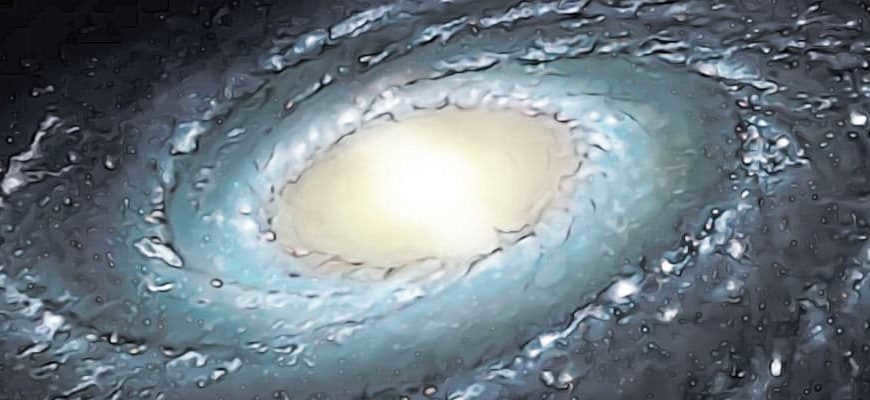
The galaxy known as the Milky Way is the celestial body that houses our Sun and all the planets of our solar system. It is also home to millions of other stars, numbering in the hundreds of millions.
When considering the structure of the Milky Way, one can envision it as a disk with a thickness of approximately 3,000 units and a diameter spanning about 180,000 light years. However, it is important to note that this depiction is a mere approximation, as the true nature of the Milky Way is far more intricate and complex.
Interestingly, determining the exact appearance of our own galaxy, the Milky Way, is a challenging task. This may seem peculiar, considering that it is the galaxy we call home. One might assume that we would possess a greater understanding of our own galaxy compared to others, which are situated millions of light years away.
Typically, they are indeed. However, here’s the catch: similar to how it can be challenging to perceive the form of a forest while being in its midst, comprehending the structure of the Milky Way is equally arduous when one is situated within it. Nonetheless, astronomers have undoubtedly acquired a wealth of knowledge about it throughout the years.
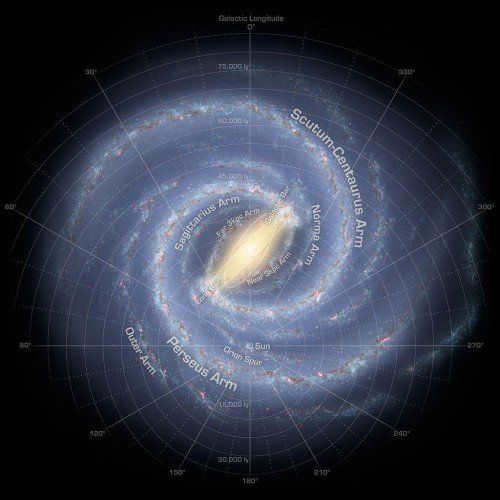
Spiral arms
Researchers have identified that our Milky Way galaxy is classified as a “spiral arm spiral galaxy”. This categorization means that it can be roughly divided into three primary components. Positioned at the core of this galaxy is a spherical region called the “bulge” which spans approximately 16,000 light-years in diameter. Within this central area, there exists a “junction” – a relatively straight band comprising of luminous stars. Extending outwards from this junction are spiral arms which are situated within the galactic disk encircling both the bulge and the junction.
Let’s delve deeper into the characteristics of these spiral arms.
It was not until the 1920s that astronomers discovered the existence of galaxies, revealing the fact that the Milky Way has spiral arms. American astronomer Edwin Hubble and his colleagues made this groundbreaking realization when they observed the Andromeda Nebula and determined that it was actually a vast cluster of stars, not a nebula. Despite its appearance as a hazy cloud in the sky, it is in fact a distant and expansive star cluster.
This significant revelation led scientists to understand that our own Milky Way is also a galaxy, akin to a floating island of stars in the vastness of the universe. As telescopes advanced, astronomers continued to observe more and more distant galaxies, each with their own unique shapes. Among these galaxies were numerous examples of spiral galaxies. However, the external appearance of the Milky Way remained a mystery.
Exploration
On December 26, 1951, an American astronomer named William Morgan delivered a speech at the conference of the American Astronomical Society in Cleveland. To everyone’s surprise, the audience not only applauded, but also stomped their feet in excitement. This level of enthusiasm was quite unusual for a scientific conference.
During his 15-minute presentation, Morgan shared the findings of his research conducted in collaboration with Donald Osterbrock and Stuart Sharpless. The team of astronomers had observed numerous large, luminous, and hot stars, carefully documenting their positions and distances. Interestingly, these types of stars are commonly found in the spiral arms of galaxies. However, the groundbreaking discovery came when the scientists realized that the Milky Way also exhibited structures resembling spiral arms, just like other galaxies.
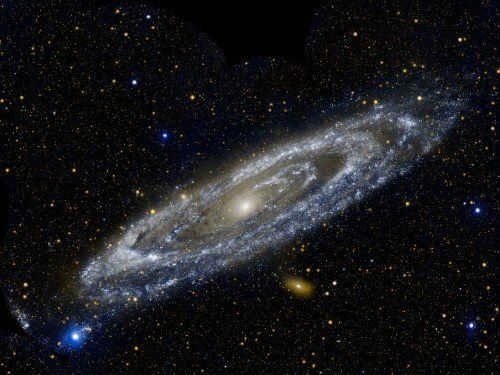
What exactly are spiral arms?
During the mid-20th century, scientists made a fascinating discovery about our galaxy, the Milky Way – it has spiral arms. But what are these spiral arms exactly? The Milky Way consists of two primary spiral arms, namely the Perseus Arm and the Centauri Arm, along with several smaller arms. The Perseus Arm derives its name from the fact that its stars are highly visible from Earth, appearing in the constellation Perseus. However, it is important to note that this arm stretches across the entire Milky Way, originating from one end of the junction at the galactic center. As it spirals through the disk, it gradually approaches the region where our Solar System is situated. In fact, the minimum distance between the Sun and the Perseus Arm is a mere 6,350 light years, making it the closest major spiral arm to us within the Milky Way.
The Centaurus Arm is the second major spiral arm of the Milky Way, originating from the opposite side of the galactic junction. Between the Perseus and Centauri arms, there exist multiple smaller arms, one of which is the Orion Arm that encompasses our own solar system. Stretching over a distance of 10,000 to 20,000 light-years and spanning 2,000 light-years in width, the Orion Arm is home to our Sun, situated at its inner edge, closer to the galactic center. Our current position lies within a small aperture within the Orion Arm known as the local bubble, characterized by a relatively low concentration of interstellar gas. Scientists hypothesize that this particular region was formed as a result of various supernova explosions in the past.
Another small spiral arm in the Milky Way is the Sagittarius arm, which is located between the Perseus arm and the Naugol arm. This makes the Sagittarius arm our neighboring spiral arm. The Naugol arm, on the other hand, is much farther away from us and is considered the innermost spiral arm from our perspective.
If we were to travel in a straight line towards the center of the galaxy, we would first pass through the Sagittarius arm, followed by the Centauri arm, and finally the Naugol arm. On the return journey, we would encounter the Perseus arm, and it is possible that we may come across the Naugol arm again as it wraps around the Milky Way. However, there is also a possibility of encountering a different arm that is unrelated to the Naugol arm. The structure of the galaxy is quite complex.
It’s a challenging scenario
Regrettably, astronomers have yet to obtain a complete understanding of the arrangement of stars within the Milky Way due to their staggering number, which surpasses several hundred billion. Furthermore, determining their precise luminosity, location, and distance from one another is imperative. Only with this information in hand can a comprehensive map of our Galaxy be constructed, revealing all the spiral arms and interconnections that permeate it. It’s not merely arduous; it’s nearly insurmountable!

